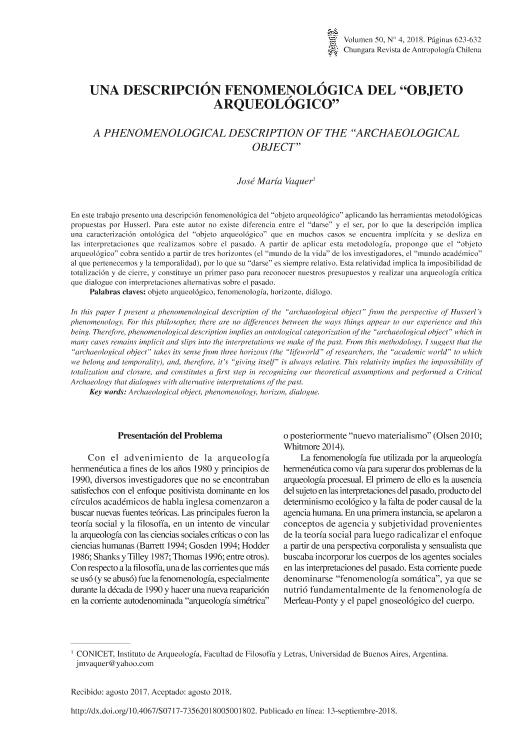Mostrar el registro sencillo del ítem
dc.contributor.author
Vaquer, Jose Maria

dc.date.available
2022-11-11T11:37:48Z
dc.date.issued
2018-10
dc.identifier.citation
Vaquer, Jose Maria; Una descripción fenomenológica del "objeto arqueológico"; Universidad de Tarapacá; Chungara; 50; 4; 10-2018; 623-632
dc.identifier.issn
0717-7356
dc.identifier.uri
http://hdl.handle.net/11336/177413
dc.description.abstract
En este trabajo presento una descripción fenomenológica del “objeto arqueológico” aplicando las herramientas metodológicas propuestas por Husserl. Para este autor no existe diferencia entre el “darse” y el ser, por lo que la descripción implica una caracterización ontológica del “objeto arqueológico” que en muchos casos se encuentra implícita y se desliza en las interpretaciones que realizamos sobre el pasado. A partir de aplicar esta metodología, propongo que el “objeto arqueológico” cobra sentido a partir de tres horizontes (el “mundo de la vida” de los investigadores, el “mundo académico” al que pertenecemos y la temporalidad), por lo que su “darse” es siempre relativo. Esta relatividad implica la imposibilidad de totalización y de cierre, y constituye un primer paso para reconocer nuestros presupuestos y realizar una arqueología crítica que dialogue con interpretaciones alternativas sobre el pasado.
dc.description.abstract
In this paper I present a phenomenological description of the “archaeological object” from the perspective of Husserl´s phenomenology. For this philosopher, there are no differences between the ways things appear to our experience and this being. Therefore, phenomenological description implies an ontological categorization of the “archaeological object” which in many cases remains implicit and slips into the interpretations we make of the past. From this methodology, I suggest that the “archaeological object” takes its sense from three horizons (the “lifeworld” of researchers, the “academic world” to which we belong and temporality), and, therefore, it’s “giving itself” is always relative. This relativity implies the impossibility of totalization and closure, and constitutes a first step in recognizing our theoretical assumptions and performed a Critical Archaeology that dialogues with alternative interpretations of the past.
dc.format
application/pdf
dc.language.iso
spa
dc.publisher
Universidad de Tarapacá
dc.rights
info:eu-repo/semantics/openAccess
dc.rights.uri
https://creativecommons.org/licenses/by/2.5/ar/
dc.subject
OBJETO
dc.subject
ARQUEOLOGICO
dc.subject
FENOMENOLOGIA
dc.subject
DIALOGO
dc.subject.classification
Arqueología

dc.subject.classification
Historia y Arqueología

dc.subject.classification
HUMANIDADES

dc.title
Una descripción fenomenológica del "objeto arqueológico"
dc.title
A phenomenological description of the “archaeological object”
dc.type
info:eu-repo/semantics/article
dc.type
info:ar-repo/semantics/artículo
dc.type
info:eu-repo/semantics/publishedVersion
dc.date.updated
2022-11-11T10:49:22Z
dc.journal.volume
50
dc.journal.number
4
dc.journal.pagination
623-632
dc.journal.pais
Chile

dc.journal.ciudad
Arica
dc.description.fil
Fil: Vaquer, Jose Maria. Consejo Nacional de Investigaciones Científicas y Técnicas; Argentina. Universidad de Buenos Aires. Facultad de Filosofía y Letras. Instituto de Arqueología; Argentina
dc.journal.title
Chungara
dc.relation.alternativeid
info:eu-repo/semantics/altIdentifier/url/http://www.chungara.cl/Vols/2018/AOP/AOP-J_M_VAQUER.pdf
dc.relation.alternativeid
info:eu-repo/semantics/altIdentifier/doi/http://dx.doi.org/10.4067/S0717-73562018005001802
Archivos asociados
